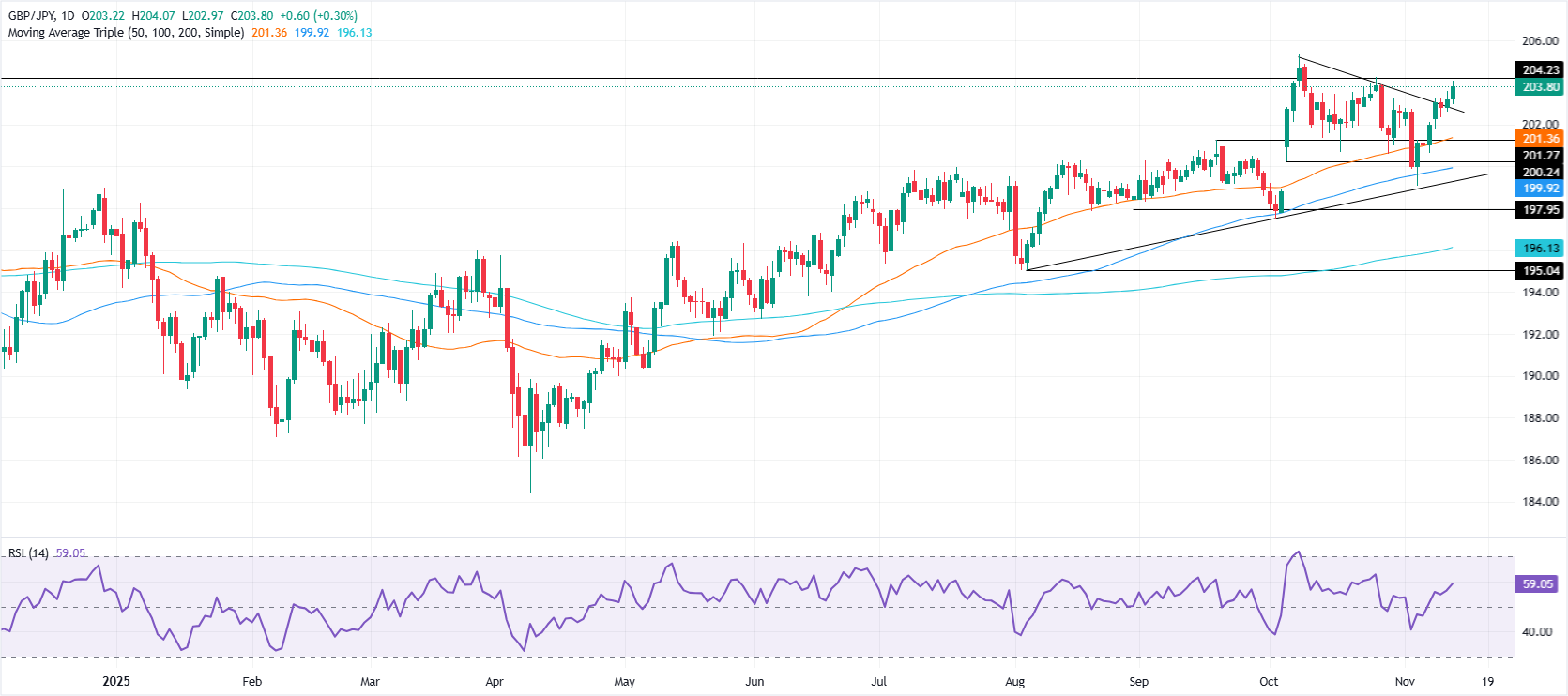GBP/JPY Price Forecast: nears 204.00 as uptrend stalls amid intervention threats
- GBP/JPY rises 0.22% to 203.82, holding above 20-day SMA at 202.48 as bullish structure remains intact.
- Buyers face stiff resistance at 204.00, with upside targets at 205.00 and yearly peak of 205.32.
- RSI supports bullish bias, though a drop below 202.48 could expose deeper pullback toward 201.36 support.
The GBP/JPY prolongs its gains on Thursday up a modest 0.22%, distancing from the 20-day Simple Moving Average (SMA) at 202.48, seen as the first support area for the cross-pair. At the time of writing, the cross trade at 203.82 shy of reclaiming the 204.00 milestone.
The rally has stalled as Satsuki Katayama, Japan’s finance minister, said the government is monitoring “one‐sided and rapid currency moves” with high urgency.
GBP/JPY Price Forecast: Technical outlook
The technical picture shows the GBP/JPY is upward biased, but buyers are facing strong resistance at 204.00. If breached the next area of interest would be 205.00 ahead of the yearly high of 205.32 hit in early October. On further strength 206.00 is up next.
The Relative Strength Index (RSI) further confirms bias, but due to its closeness to the 50-neutral level a breach beneath the latter could drive the GBP/JPY lower.
On further GBP/JPY weakness, a drop below the 20-day SMA at 202.48, clears the path to challenge the 50-day SMA at 201.36.
GBP/JPY Price Chart – Daily

Pound Sterling FAQs
The Pound Sterling (GBP) is the oldest currency in the world (886 AD) and the official currency of the United Kingdom. It is the fourth most traded unit for foreign exchange (FX) in the world, accounting for 12% of all transactions, averaging $630 billion a day, according to 2022 data. Its key trading pairs are GBP/USD, also known as ‘Cable’, which accounts for 11% of FX, GBP/JPY, or the ‘Dragon’ as it is known by traders (3%), and EUR/GBP (2%). The Pound Sterling is issued by the Bank of England (BoE).
The single most important factor influencing the value of the Pound Sterling is monetary policy decided by the Bank of England. The BoE bases its decisions on whether it has achieved its primary goal of “price stability” – a steady inflation rate of around 2%. Its primary tool for achieving this is the adjustment of interest rates. When inflation is too high, the BoE will try to rein it in by raising interest rates, making it more expensive for people and businesses to access credit. This is generally positive for GBP, as higher interest rates make the UK a more attractive place for global investors to park their money. When inflation falls too low it is a sign economic growth is slowing. In this scenario, the BoE will consider lowering interest rates to cheapen credit so businesses will borrow more to invest in growth-generating projects.
Data releases gauge the health of the economy and can impact the value of the Pound Sterling. Indicators such as GDP, Manufacturing and Services PMIs, and employment can all influence the direction of the GBP. A strong economy is good for Sterling. Not only does it attract more foreign investment but it may encourage the BoE to put up interest rates, which will directly strengthen GBP. Otherwise, if economic data is weak, the Pound Sterling is likely to fall.
Another significant data release for the Pound Sterling is the Trade Balance. This indicator measures the difference between what a country earns from its exports and what it spends on imports over a given period. If a country produces highly sought-after exports, its currency will benefit purely from the extra demand created from foreign buyers seeking to purchase these goods. Therefore, a positive net Trade Balance strengthens a currency and vice versa for a negative balance.

